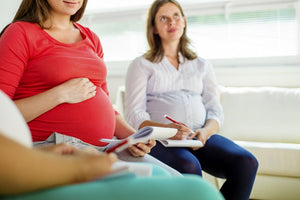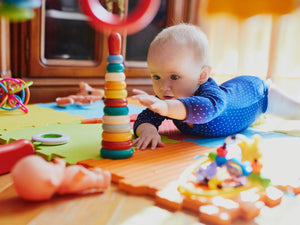How would you communicate if you couldn’t talk, walk or point? It would be seriously tough to get through the day.
Welcome to your baby’s world of no words and limited muscle coordination. It is not that babies don’t need to communicate; they just do it differently to adults.
So how do babies communicate? Let's explore.
Eyes
- Babies will look into your eyes when they want to ‘chat’ to you and when they are done, they will look away.
- When overwhelmed your baby may avoid eye gaze.
- When interacting with the world around them, their eyes are bright, alert and sparkling.
- When greeted by a stranger they may look to you for reassurance before they can will hold eye contact with the stranger.
- When they are tired they become glazed and unfocussed.
- When someone looms into their face, they may close their eyes or quickly look away, because they can’t run away.
Facial expression
- Watch for those fleeting frowns that are telling you that your baby is not relaxed and if ignored, they may just start crying.
- The relaxed open looking face shows they are ready to ‘chat’ expression.
Body movements
- Fluid, rhythmical movements indicated a calm central nervous system.
- Jittery, jerking means the baby’s central nervous system is working hard and they are either tired, hungry or just need a cuddle to help them calm.
- Tense outstretched fingers also indicates an alert state, it could be just fleeting, but it can mean baby is not calm, perhaps just focused or feeling a little tense.
- Arms across chest firmly may mean your baby is trying to calm themselves because they are feeling challenged by the external world.
Skin colour
- Even coloured skin (not referring to rashes or eczema) means the circulation is flowing along nicely.
- Mottled skin means baby’s body is under stress, and may need a cuddle to help calm.
Sucking; hands, dummy or anything
- Sucking is one of the few actions babies can really do well to soothe themselves. Feeding is soothing, but when your baby has a wind bubble, or distressed, they may also suck. SO just to confuse you, sucking doesn’t always mean hunger. If you have fed recently and you are pretty sure they have had a good feed, maybe they just need to suck on a dummy briefly so they can self soothe.
Body orientation
- Babies will curl in towards you when they are hungry.
- After a feed when feeling happy they will be relaxed in an open position.
- Babies will move in towards your body to seek safety.
- Some babies are more cuddly than others and blend into your body when relaxed.
- A distressed baby will draw their legs up or straighten them and their body is tense.
Voice; without words, sounds matter
- A grizzle of a fussing sound often means your baby is trying to manage something, and if it escalated, they need your help because what ever it is has not been resolved.
- Crying, no matter what emotional label that people may give it, is a cry.
- Crying babies need care. We don’t always know what care, but by you offering comforting, it will help your baby manage the dis-regulated state more readily.
Never dismiss your baby’s behaviour because it allows you to see what they are trying to tell you. Don’t worry if don’t figure out what they are needing every time, because if you get it right about 30% of the time and try again, that is adequate for babies to feel safe within their relationship with you.
About the Author:
Helen Stevens; Early Parent & Infant Consultants (EPIC Baby Sleep). RN. RM. MCHN. Published author, Infant Mental Health practitioner, Educator and Researcher, specialising in infant and toddler sleep worldwide.You may also like:
Our Products
-

01. Guide to a Healthy Pregnancy
$55 -

02. Positive Birthing Course
$55 -

03. Infant Feeding Guide
$55 -

04. Baby Sleep Guide - First 12 Months
$55 -

05. Toddler Parenting Course 1 - 3 Years
$55
-
 When to Start Antenatal Classes?
When to Start Antenatal Classes?
Becoming a parent is an incredible milestone, but it comes with a host of changes that can be daunting, especially for first time parents. Antenatal classes are all about offering expectant parents the education they need to make informed decisions, look after their bodies and care for their newborn babies. While you probably already have a long list of things you need to accomplish during your pregnancy, it’s a good idea to make time to attend antenatal classes.
-
 Development Milestones 4-8 Months
Development Milestones 4-8 Months
As they reach the middle of their first year, you'll start to see bigger leaps in their growth and ability!
In this article, we’re going to discuss your baby’s developmental milestones between 4-8 months, and what you can expect along the way.





 When to Start Antenatal Classes?
When to Start Antenatal Classes?
 Development Milestones 4-8 Months
Development Milestones 4-8 Months








